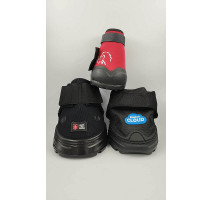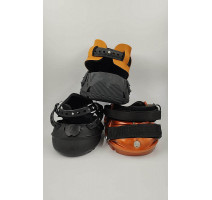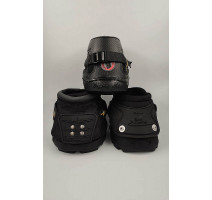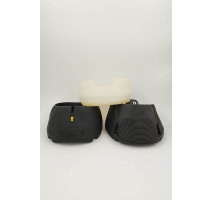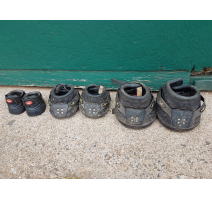Hoofboots
Hoofboots are very old and started with the romans. They have been replaced by iron shoes and came back about 30 years ago.
Because of medern materials they are tough and easy to use
Hoofboots allow a better fonctionning of the horse hoof
- You don't know to make holes in the wall so the horn will become better in terms of quality
- Hoofboots show less athrosis and tendon problems on older horses . The rubber soften the contact with hard ground .
- The horse will have no pain on his sole because of stones
- You won't take the risk of dangerous kicks when your horse is out in a paddock
- Hoofboots avoid slipping on tarmac or stones when out hacking

Subcategories
-
Therapy boots are used for a wide range of temporary conditions and problems.
When are therapy boots useful?
A therapy boot is used when the horse is not working. They are intended for use in the stable or paddock, but not for work or in large meadows.
This therapy boot must first and foremost be comfortable and will be similar to a slipper.
Except for a very short period of time or for a very thin sole boot, it is advisable to put boots on both feet (right and left) in order to maintain lateral balance of the horse and to avoid causing other pathologies.
The first and easiest case could be the loss of an iron shoe on a shod horse, which risks damaging its hoof if left unprotected.
Your horse may also suffer after a shoe removal, while waiting for the hoof to strengthen.
The therapy boot can also be used during transport so that your horse does not suffer from the vibrations of the road. The therapy boot will absorb these shocks.
More serious pathologies may require the use of a therapy boot: in the event of laminitis (acute or chronic), the horse will be immediately relieved by a boot with a thick outer sole and a shock-absorbing inner sole.
In periods of heavy rain and muddy fields, you can have your horse wear boots to prevent the effects of mud.
If a therapy boot is out of stock, it can sometimes be replaced by a working boot: call us on this line for more information on this subject : 0033 (0)474887903.
How do I choose a therapy boot?
There are many different types of therapy boots, they are chosen according to use.
If the horse remains in a stable and the foot is not sensitive (shoe pulling, bandaging), you can choose a thin sole boot.
If the horse goes out to the paddock, you'll need a thicker, sturdier sole boot, but you won't need much cushioning.
If the horse is in a lot of pain (laminitis), you'll need to choose a boot with a thick sole that insulates it from the ground, plus an inner sole that absorbs ground vibrations and insulates the sole from the hoof.
The fit will not be as close to the foot as for a working boot. This is one of the reasons why they cannot be used for work.
Therapy Hoofboots are not designed to be worn in large spaces, as they will deteriorate very quickly.
Nor are they designed to be put on horseshoes. In this case, the guarantee would not apply.
Please call 0033 (0)474887903 after taking precise measurements of each foot for further advice.
-
These hoofboots are light and close to the foot, but require more regular hoof monitoring.
When should close fitting hoofboots be used?
The choice of boots depends on the number of hours the horse will be wearing them. It's not a question of strength or sturdiness, but mainly friction with the skin. It is not a question of comfort and cushioning of the sole either.
Close contact hoofboots are 'nicer' to look at and seem easier to use. In fact, it is almost the opposite.
They are lighter, lower, less massive, the water flows better and they are less heavy.
On the other hand, they do not suit every horse, because they require a well-formed hoof, with a regular shape, otherwise the boot will not fit closely around the hoof wall and they will not stay on.
Similarly, you will not have any "room" for the hoof to grow, so you will need regular trimming and maintenance by yourself between two visits from your trimmer or farrier.
Close fitting hoofboots are ideal for long-distance riding and endurance.
Do not rely solely on the sleek lines of certain boots to make your choice. You should base your choice on your skills and experience of trimming and hoofboots.
How do I choose a hoofboot?
There are several models of hoofboots.
First of all, of course, you have to rely on the measurements, because there is a lot of difference between each model: the shapes vary as well as the design. Not all models will fit all horses.
If your horse is “outside the box” in terms of size (pony or draught horse) you will have little choice.
Otherwise, you will have to decide according to your personal preferences:
Some hoofboots are adjusted with cables that become wearing parts and are replaced when they threaten to break. The hoofboots will last longer, but you will need to change the cables from time to time.
Other people prefer rubber straps, which are more reassuring for non-do-it-yourselfers, to adjust the length and/or height at heel level.
Some models don't have a fastening system and just work by suction cup: practical, but as soon as there is a gap between the hoof and boot, it will not work anymore.
Please call us on this line 0033 (0)474887903 for further questions, but only after taking precise measurements of each foot.
We recommend the use of a fitting kit before purchase of a boot in this category (close contact).
-
Most people use wrap-around horse boots. They are the easiest to use and the most forgiving when it comes to trimming.
When should I use wrap-around hoofboots?The choice of horse boots depends on the number of hours the horse will be wearing them. It's not a question of strength or sturdiness, only rubbing against the skin.
Wrap-around boots are recommended for up to 10 to 12 hours a week.
Of course, this varies from one horse to another, some having more fragile skin than others. Some horses can keep them on for 8 hours a day for a week, others cannot.
You should also be aware that the tighter the boot strap, the lower the risk of rubbing. If it is very loose, in addition to the risk of it turning and you losing it, there will be more rubbing.
To minimise the risk of irritation, you need to follow the procedure for 'breaking in' your boots and use talcum powder when you first use them (never use greasy products, as your boot will slide around like a ring with soap). And above all, think ahead: do not order your boots in a hurry the week before the trail!
And do not forget: some second-hand boots (like human shoes) may have been deformed if the foot was not adapted to the boot or if it was badly used.
In some hoofboots, additional protection can be added to the inside of the shoe to limit irritation.
Modern materials help to reduce problems, and chafing is now rare if you have chosen the right model and the right size, and if you have done regular trimming and a good "breaking-in".
With wrap-around boots, you can go hiking for a weekend. If you want to go away for a week or more, you'll have to opt for a close-fitting boot.
With wrap-around hoofboots, you can also do short endurance races (generally up to 40 km), work on the flat, trotting and jumping.
These boots are generally easier to fit on the hoof, as they rise higher and are harder to "throw off", so they are generally the ones to choose for difficult conditions, such as steep gradients and jumping...
How do I choose a wrap-around boot?
The size of the foot will be the ultimate judge. There is no question of choosing a boot that looks attractive but is not shaped to fit your horse's hooves.
You will need to determine the shape of the foot: is there a difference between the width and the length? Be careful, the accuracy must be to the nearest millimetre.
If the values are equivalent, we will call this foot "round".
If the foot is longer than it is wide, what is the difference? 0.5 cm? 1 cm? more?
Or is the foot wider than it is long?
If the measurements seem abnormal, do not hesitate to go back and measure the hoof.
Are you sure you have not measured the heel bulbs? Did you stop at the end of the lateral sulci?
If the hoof is wider than it is long, are there flares or not? Draft horses, in particular, are used to this and a simple rasp to the right and left can solve the problem.
It is important to choose your boot after a well-executed trimming and then to preserve the shape and size of the hoof. Hoofboots will not meet your expectations and will deteriorate more quickly if you allow the hooves to grow too much.
Once the measurements have been determined, all you have to do is look in the charts for boots that match this shape.
Some models come in 2 shapes: round and oval. Others are adaptable in length. And some are somewhere in between.
It is all up to you! But do not panic, if you cannot figure it out on your own, we are here to help (0033 (0)4 74 88 79 03).
Sometimes, however, you will have several models to choose from. It will then be up to you to read through the advantages of each boot and decide what is closest to your heart, or simply what you like best: at this stage, trust your intuition (and not the comments of friends who have a horse completely different from yours...).
Please call us again at this stage to find the characteristic that will be important to you in your hoofboot choice.
-
whatever your hoofboot, you will find the accessory you need, either to repair a broken part or to take with you as a spare part
-
All hoofboot models we offer are here, from miniature horses to draught horses and mules, from a close contact around the foot to wrap-around boots, veterinary or intended for sport, numerous models to suit all your activities and needs.

